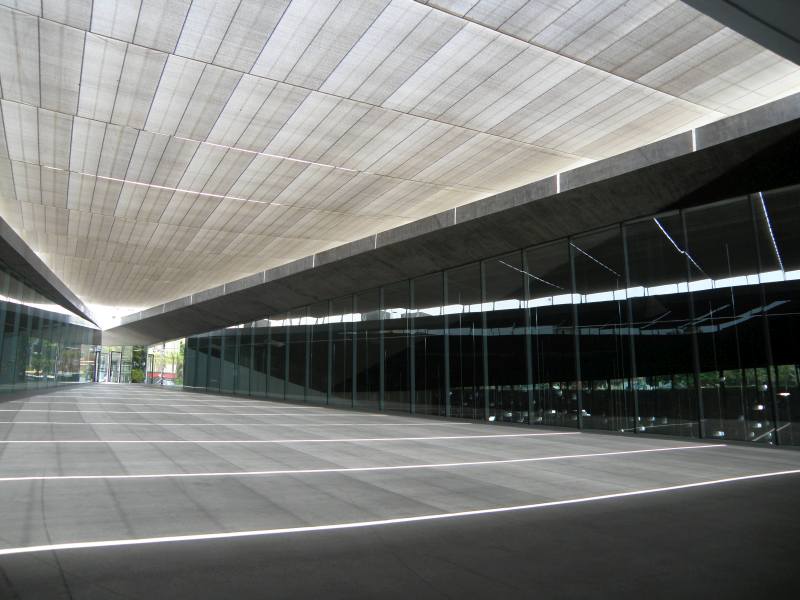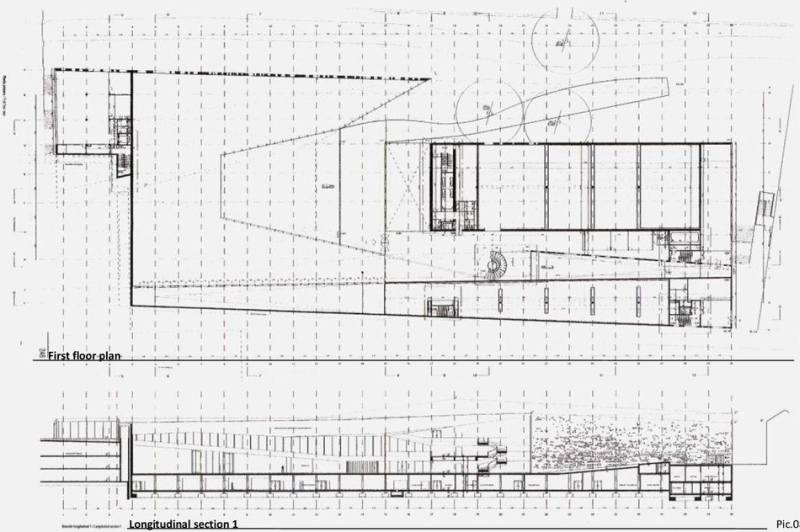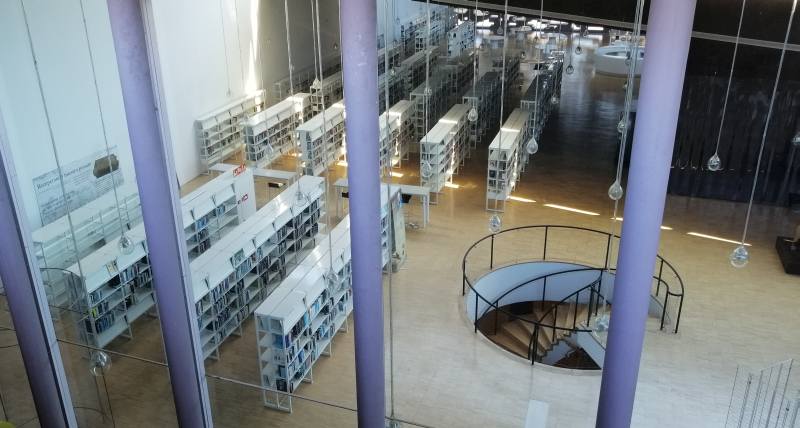En esta serie echamos un vistazo a los museos y galerías, pero no en cuanto a su contenido, sino desde el punto de vista arquitectónico e institucional. Hay verdaderas joyas, y a propuesta de mi amiga y habitual colaboradora Shirley Rebuffo, publicamos imágenes e información sobre la construcción y características de edificios que albergan las colecciones de ese arte que tanto amamos y que desde este blog ayudamos a difundir día a día.
Como línea general, iremos recorriendo museos que hemos visitado personalmente.
Presentamos hoy el TEA (Tenerife Espacio de las Artes), en una entrega doble. En el primer post una descripción, los exteriores y planos. En el segundo, vistas del interior y un apunte biográfico sobre los arquitectos involucrados en el proyecto.
In this series we take a look at museums and galleries, but not in terms of content, but from an architectural and Institutional point of view. There are real jewels, and on the proposal of my friend and habitual collaborator Shirley Rebuffo we publish images and information on the construction and characteristics of buildings that house the collections of this art that we love and that from this blog we help to spread day by day .
As a general line, we will go through museums that we have personally visited.
We present today the TEA (TSA, Tenerife Space of Arts), in a double issue. In the first post, description, the exteriors, and plans. In the second one, interior views and a biographical note on the architects involved in the project.
_________________________________________________
Tenerife Espacio de las Artes (TEA) /
Tenerife Space of Arts (TSA)
Av. de San Sebastián, 8, Santa Cruz de Tenerife
Islas Canarias, España / Canary Islands, Spain
Idea y Texto / Idea & Text: Shirley Rebuffo
Fotos / Photos: S.R. & Javier Fuentes
Entrada / Entrance. Foto / Photo: Javier Fuentes, 6/2020
Es un centro dependiente del Cabildo de Tenerife. El TEA tiene entre sus objetivos el de contribuir a la reflexión sobre la cultura y la sociedad contemporánea, desde el arte del siglo XX y XXI, abriendo sus puertas el 31 de octubre de 2008.
Este complejo arquitectónico de aproximadamente 20.622 metros cuadrados alberga un museo, el Centro de Arte Contemporáneo, el Centro de Fotografía Isla de Tenerife y la Biblioteca Municipal Central. Disponiendo además de un salón de actos, un restaurante, una tienda, una plaza pública y numerosas oficinas, entre las que se encuentran las unidades de patrimonio, cultura y educación del Cabildo de Tenerife.
Entrada, Tienda / Entrance, Shop. Foto / Photo: Javier Fuentes, 6/2020
Entrada, Plaza / Entrance, Square. Foto / Photo: Javier Fuentes, 6/2020
Se localiza en un enclave privilegiado, en la zona centro de la ciudad de Santa Cruz de Tenerife, capital de la isla de Tenerife (Canarias, España), en los márgenes del Barranco de Santos, entre el Mercado de Nuestra Señora de África y la Iglesia de la Concepción y justo al lado del MUNA (Museo de Naturaleza y Arqueología).
El inmueble fue proyectado por el estudio de arquitectos suizos Herzog & de Meuron, y dirigido por el arquitecto canario Virgilio Gutiérrez Herreros.
Su diseño propicia la apertura hacia el exterior de sus espacios interiores, aportando luz y dinamismo a todo el conjunto y conectando el barrio antiguo de la ciudad con la zona moderna. Este espacio contiene una plaza pública, abierta y accesible a los visitantes, cuya función principal es la de conducir al público al interior del edificio.
Entrada, Plaza / Entrance, Square. Foto / Photo: Javier Fuentes, 6/2020
Calle Aguere / Aguere Street. Foto / Photo: Javier Fuentes, 6/2020
El proyecto arquitectónico fue realizado adaptándose en la diagonalidad espacial a un complicado emplazamiento angosto, con una fuerte pendiente, propias del terreno de esta isla de origen volcánico, junto a un barranco y en pleno centro urbano.
Para ello, los arquitectos optaron por crear un volumen compacto (aprovechando al máximo la horizontalidad), con en una serie de elementos diagonales en planta y unos suelos inclinados que incluyen una rampa, de manera que el espacio público en la entrada principal penetra en el edificio y confluye en el patio. Ese espacio genera una plaza triangular.
Los diversos edificios y entradas que conforman el espacio cultural aparecen así entrelazados y conectados, pero sin perder su individualidad dentro del conjunto. El acceso a TEA es posible desde distintas partes de la ciudad ya que una nueva vía pública discurre diagonalmente a través del edificio conectando la parte superior del puente Serrador con la cota inferior de la orilla del barranco de Santos.
Calle Aguere / Aguere Street. Foto / Photo: Javier Fuentes, 6/2020
Uno de los rasgos más característicos del edificio es su fachada de hormigón, perforada con un sinnúmero de pequeños vanos (1.200 cristales, 720 formas diferentes), que consiguen para el edificio una fachada muy atractiva y dinámica desde el punto de vista visual, que además filtra la transferencia de luz hacia el interior. Con ellos se consigue una peculiar distribución de luminocidad natural que se combina con una gran malla de hilos de luz a modo de lámparas. Estas formas se obtuvieron a partir del tratamiento digital de una referencia vinculada con Canarias: el pixelado ampliado de una fotografía de los reflejos del sol sobre el mar, aplicada al hormigón de las fachadas y a la apertura de huecos.
Desde el acceso principal, y descendiendo por la escalera de caracol de la entrada, se llega a la cafetería, junto a las columnas que flanquean dos ascensores. Frente a esas columnas, se encuentra la Biblioteca y un amplio espacio que da a una cristalera hacia la calle San Sebastián, con una zona flanqueada por seis palmeras de ocho metros, sobre cada una de las cuales hay una claraboya que les otorga luz natural. Asimismo, colgando hacia esta zona verde, cae una enredadera que forma parte de la fachada interior, otorgando al usuario la sensación de estar dentro de un recinto ajardinado.
Plano de la primera planta / First Floor Plan - Plano de la Segunda Planta / Second Floor Plant
Corte longitudinal / Longitudinal Section. Fuente / Source: AC / CA
Fuente / Source: AC / CA
El edificio, al igual que el barranco junto al que se sitúa, enlaza con las edificaciones y niveles que lo rodean, y sus volúmenes geométricos tienen que ver con la estratificación, los planos y líneas del paisaje en el que está enclavado. De esta forma da respuesta a las dificultades de la gran infraestructura desde el punto de vista urbano, estético, topográfico y geográfico. La estrategia llevada adelante fue afrontada desde el método y no desde el estilo, lo que permitió desarrollar una obra amplia y de gran calidad.
Vista aérea / Aerial View. Google Earth
«TEA es más que un edificio. Es una calle. Y la calle es la esencia del encuentro y de la convivencia. TEA construye, por tanto, la ciudad. Resuelve la transición entre la ciudad fundacional y, digamos para entendernos, el 'ensanche', dando solución a los problemas de topografía y de diferencia de cotas que existía entre ambas partes, antes inconexas entre sí. TEA es un ejemplo significativo de respuesta a uno de los mayores retos de la arquitectura contemporánea: la construcción del espacio público». Virgilio Gutiérrez Herreros
Corte longitudinal 3 / Longitudinal Section 3 - Plano de la planta baja / Ground Floor Plan
Corte longitudinal 4 / Longitudinal Section 4. Fuente / Source: TEA
Plano de la primera planta / First Floor Plan - Corte longitudinal 1 / Longitudinal Section 1. Fuente / Source: TEA
It is a center dependent on the Cabildo of Tenerife. The TSA has among its objectives to contribute to the reflection on culture and contemporary society, from the art of the 20th and 21st century, opening its doors on October 31, 2008.
This architectural complex of approximately 20,622 square meters houses a Museum, the Center of Contemporary Art, the Center of Photography Island of Tenerife and the Central Municipal Library. It also has an assembly hall, a restaurant, a shop, a public square and numerous offices, including the heritage, culture and education units of the Cabildo de Tenerife.
Plano del nivel superior / Upper Level Plant - Elevación norte / North Elevation. Fuente / Source: TEA
Cortes / Sections. Fuente / Source: TEA
It is located in a privileged spot, in the central area of the city of Santa Cruz de Tenerife, capital of the island of Tenerife (Canary Islands, Spain), on the margins of the Santos Ravine, between the Market of Our Lady of Africa and the Church of the Conception and right next to the MUNA (Museum of Nature and Archaeology).
The building was designed by the Swiss architectural studio Herzog & de Meuron, and directed by the Canary Islands architect Virgilio Gutiérrez Herreros.
Its design favours the opening of its interior spaces to the outside, bringing light and dynamism to the whole complex and connecting the old quarter of the city with the modern area. This space contains a public square, open and accessible to visitors, whose main function is to lead the public inside the building.
Maqueta / Model. Fuente / Source: AC / CA
Avenida de San Sebastián / St. Sebastian Avenue. Foto / Photo: Javier Fuentes, 6/2020
The architectural project was carried out by adapting the spatial diagonality to a complicated narrow location, with a strong slope, typical of the terrain of this island of volcanic origin, next to a ravine and in the heart of the city.
To this end, the architects chose to create a compact volume (taking maximum advantage of horizontality), with a series of diagonal elements on the floor plan and sloping floors that include a ramp, so that the public space at the main entrance penetrates the building and converges in the courtyard. This space generates a triangular square.
The various buildings and entrances that make up the cultural space thus appear intertwined and connected, but without losing their individuality within the whole. Access to TSA is possible from different parts of the city as a new public road runs diagonally through the building connecting the upper part of the Serrador bridge with the lower part of the Santos ravine bank.
Avenida de San Sebastián / St. Sebastian Avenue. Foto / Photo: Javier Fuentes, 6/2020
Avenida de San Sebastián / St. Sebastian Avenue. Foto / Photo: Shirley Rebuffo, 2/2020
One of the most characteristic features of the building is its concrete façade, perforated with a number of small openings (1,200 panes, 720 different shapes), which give the building a very attractive and dynamic façade from the visual point of view, which also filters the transfer of light towards the interior. They achieve a peculiar distribution of natural light that is combined with a large mesh of light threads as lamps. These shapes were obtained through the digital treatment of a reference linked to the Canary Islands: the enlarged pixelation of a photograph of the reflections of the sun on the sea, applied to the concrete of the facades and to the opening of gaps.
From the main access, and descending the spiral staircase at the entrance, one arrives at the cafeteria, next to the columns that flank two lifts. Opposite these columns is the Library and a large space that looks out onto a window to San Sebastián Street, with an area flanked by six eight-metre palm trees, above each of which there is a skylight that provides them with natural light. Also hanging towards this green area is a vine that forms part of the interior facade, giving the user the sensation of being inside a landscaped enclosure.
Biblioteca / Library. Foto / Photo: Shirley Rebuffo
Biblioteca / Library. Foto / Photo: Javier Fuentes, 7/2012
The building, like the ravine next to which it is situated, links up with the surrounding buildings and levels, and its geometric volumes have to do with the stratification, the planes and lines of the landscape in which it is embedded. In this way it responds to the difficulties of large infrastructure from an urban, aesthetic point of view, topographical and geographical. The strategy carried out was faced from the method and not from the style, which allowed to develop a wide and high quality work.
Biblioteca / Library. Foto / Photo: Javier Fuentes, 6/2020
Biblioteca / Library. Foto / Photo: Javier Fuentes, 6/2020
Biblioteca / Library. Foto / Photo: Javier Fuentes, 7/2012
«TSA is more than a building. It's a street. And the street is the essence of meeting and living together. TSA therefore builds the city. It solves the transition between the city and, let's say to understand each other, the 'widening', giving solution to the problems of topography and difference in elevation that existed between both parts, previously unconnected with each other. TSA is a significant example of a response to one of the greatest challenges of contemporary architecture: the construction of public space». Virgilio Gutiérrez Herreros
Entrada, Plaza / Entrance, Square. Foto / Photo: Javier Fuentes, 11/2017
Vista aérea general / General Aerial View. Fuente / Source: TEA
____________________________________________________
Sala de exposiciones: Martes a domingo, 10:00 a 20:00 horas. /
Exhibition Hall: Tuesday to Sunday, 10 AM to 8 PM
Debido a la actual situación, sólo la sala de exposiciones está abierta, de martes a domingo, de 12:00 a 20:00 horas. Entrada libre. Aforo limitado al 30 por ciento.
La biblioteca, el cine y el MiniTEA están cerrados temporalmente.
Due to the current situation, only the exhibition hall is open, from Tuesday to Sunday, from 12 AM to 20 PM. Free entrance. Seating is limited to 30 percent.
The library, the cinema and the MiniTEA are temporarily closed.
Fuentes / Sources:
* Herzog - De Meuron Website
* Virgilio Gutiérrez Herreros Website
* Entrevista a / Interview with Virgilio Gutiérrez Herreros. Arquitectura y Empresa, 1/2016
_____________________________________________________
Serie "Casas del Arte" / Houses of Art Series
Museo / Musem Oscar Niemeyer, Curitiba, Brasil / Brazil
Museo de Arte Latinoamericano / Museum of Latin-American Art, Buenos Aires, Argentina
Fundación Iberê Camargo / Iberê Camargo Foundation, Porto Alegre, Brasil / Brazil
Museo de Arte Contemporáneo / Museum of Contemporary Art, Rosario, Argentina
Museo de Arte / Museum of Art, São Paulo, Brasil / Brazil
Museo de Arte Contemporáneo / Museum of Contemporary Art, Niterói, Rio de Janeiro, Brasil / Brazil
Museo de Artes Plásticas Eduardo Sívori / The Eduardo Sívori Museum, Buenos Aires, Argentina
Museo Internacional del Barroco / The International Museum of the Baroque, Puebla, México
[Casas del arte (VIII)]Instituto Aragonés de Arte y Cultura Contemporáneos (IAACC), Museo Pablo Serrano /
Aragonese Institute of Contemporary Art And Culture, Pablo Serrano Museum
[Casas del arte (IX-1)], [Casas del arte (IX-2)]
_____________________________________________________
Shirley Rebuffo es Licenciada en Bibliotecología y Archivología por la Escuela Universitaria de Bibliotecología y Ciencias Afines (Montevideo, Uruguay), Técnica en Museología por la Facultad de Humanidades y Ciencias (opción de Antropología), Objeto, símbolo y espacio en Curaduría. Museología Aplicada y Museología Social – Conceptos, técnicas e prácticas (Campo Grande, BR), Coaching (Campo Grande, BR), Planeamiento Estratégico (Campo Grande, BR) y estudiante de arte y pintura con el maestro Eduardo Espino.
Shirley Rebuffo has a Degree in Library Science and a Degree in Archivology by the Universitary School of Library and Related Sciences (Montevideo, Uruguay), Technician in Museology by the Faculty of Humanities and Sciences (Anthropology option), Object, Symbol and Spance in Curatorship Applied Museology and Social Museology - Concepts, Technics and Practice (Campo Grande, Brazil), Coaching (Campo Grande, Brazil), Strategic Planning (Campo Grande, Brazil), and Art and Painting student under Master Eduardo Espino.



























Buenísima descripción del edificio y de la utilización del emplazamiento.Gracias Shirley, da ganas de visitarlo..
ResponderEliminarGracias Ruben. Sí, hermoso lugar, debes darte una vuelta por Tenerife. Allí todo es hermoso.
ResponderEliminar